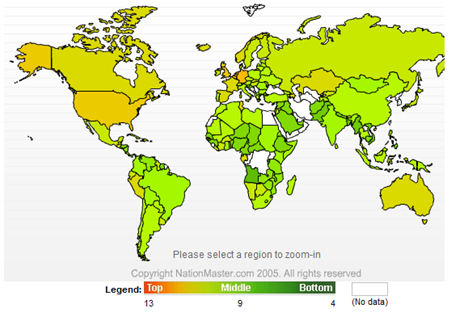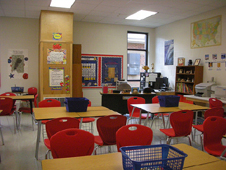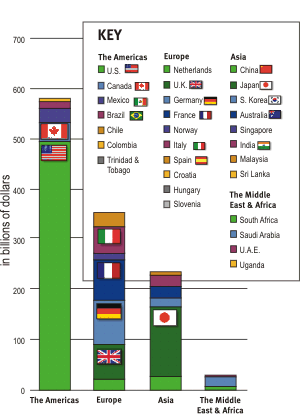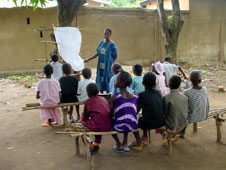

The LEDC(Less Economically Developed Country) sector includes countries with a lower GDP and a lower standard of living than MEDC (More Economically Developed Country) countries. Indicators used to classify countries as LEDC or MEDC include industrial development and education. MEDCs pursue the expansion of manufacturing industries and provide a wider access to in-classroom public education than LEDCs, which generally rely on agriculture and have less educational opportunities for their populations (Contrasts in development, 2011).
 |
 |
 |
According to statistics from NationMaster, MEDCs have longer duration of compulsory education, with some countries such as Germany having up to 13 year requirements. The United States spent the most on education in 2001 at roughly 500 billion USD, followed by Japan, Germany and France at 139 billion USD, 89 billion USD and 82 billion USD respectively. (Worldwide education and library spending, 2003). MEDCs have education systems in place and usually conduct classes indoors in traditional classroom settings. Children start attending primary school as early as the age of four in Britain (Richardson, 2009), at the age of 6 in Belgium (Belgium: Institution types and credentials, 2011), and children in United States can become a part of the educational process at the age of 3 by attending pre-school ( The U.S. education system , 2011). On average, countries mandate that children spend about 750 hours each year in primary-school classrooms (Benavot, 2004). According to statistics from NationMaster displaying numbers of instructional hours per country, the instructional time increases per grade and often exceeds the 750 mark. For example, students aged 12 in Australia on average spend 1,013 hours receiving instruction a year. ( Hours of instruction for pupils aged 12, 2011)
Because MEDCs do have equipped classrooms and spend up to 6 percent of GDP on education, incorporating biodiversity awareness into the class curriculum from early grades would guarantee that a wide audience is familiarized with biodiversity loss as a global issue.
 |
In many LEDCs, at the age of 4, girls start to assume household tasks, take care of their little brothers and sisters, replace their mothers in the house when she is engaged in agricultural work or help her with field work, livestock and handicraft work (Nestvogel, 1996). Children in LEDCs have to work to help their families and LEDCs spend significantly less money on education as comparison to their MEDC counterparts (as highlighted in Figure 3). Thus, it comes as no surprise that primary-school-age children out of school in LEDCs make up 76 percent of the world's out of school primary-school-age children, according to statistics from UNESCO Institute of Statistics. (Figure 4) Children of the lower class that do attend school in LEDCs and are not taught in the well-structured private schools of the children of upper-class families. They also do not have access to the private tutors that children from upper-class families are provided with. As a result, they often have to face poor classroom conditions. For example, in some Pakistani classrooms, children must sit on mud floors (Nestvogel, 1996).
 |
As the result of the poor conditions described above as well additional stress factors for many children attending classes becomes a traumatic activity. Because of lack of funding, spotty student attendance and lack of classrooms and furnishings, implementing curriculums dealing with the global biodiversity crisis into the LEDC classroom is not as easy as in MEDCs. As such, a different approach must be taken. Because LEDCs heavily rely on primary industries and children often participate in the workforce, practical education on biodiversity-friendly practices will be more effective.